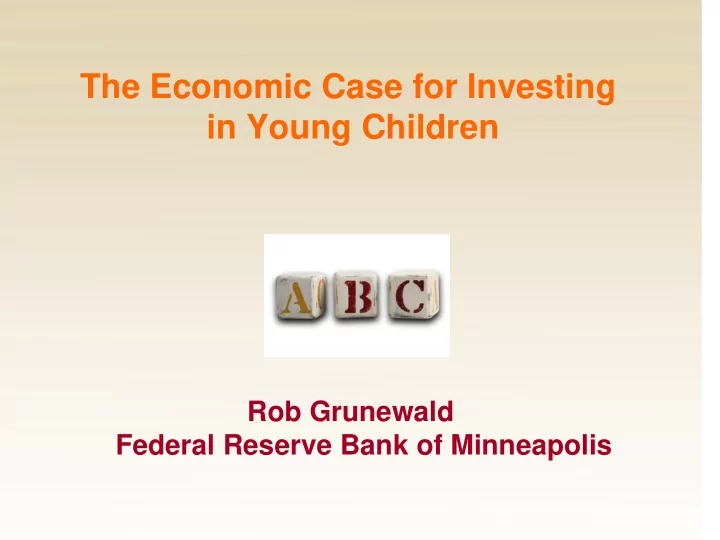

The Economic Case for Investing in Young Children Rob Grunewald Federal Reserve Bank of Minneapolis
Minnesota’s Ranking in Per Capita Personal Income 27 th • 1950s 18 th • 1970s 16 th • 1990s • 2014 15 th
Minnesota’s Education Rises Percent of Adult Population with a College Degree 40 35 30 Minnesota 25 20 United 15 States 10 5 0 1950 1960 1970 1980 1990 2000 2010 2014 Source: U.S. Census Bureau
Annual percent change in Minnesota labor force 1.6% 1.4% 1.2% 1.0% 0.8% 0.6% 0.4% 0.2% 0.0% 1990-00 2000-10 2010-15 2015-20 2020-25 2025-30 Source: Minnesota State Demographer
Hum an Brain Developm ent Synapse Form ation Dependent on Early Experiences Language Higher Cognitive Function Sensory Pathways (Vision, Hearing) FIRST YEAR -8 -7 -6 -5 -4 -3 -2 -1 1 2 3 4 5 6 7 8 9 1 0 1 1 1 2 3 4 5 6 7 8 9 1 0 1 1 1 2 1 3 1 4 1 5 1 6 1 7 1 8 1 9 Birth (Months) (Years) Source: Nelson (2000)
Human Brain 6 Years Old 14 Years Old at Birth Source: Chugani, Phelps & Mazziotta (1987)
Barriers to Social Mobility Em erge at a Very Young Age Cum ulative Vocabulary ( W ords) 1 2 0 0 College Educated Parents 6 0 0 W elfare Parents 2 0 0 1 6 m os. 2 4 m os. 3 6 m os. Child’s Age ( Months) Source: Hart & Risley (1995)
Risk Factors for Adult Heart Disease are Em bedded in Adverse Childhood Experiences 3.5 3 Odds Ratio 2.5 2 1.5 1 0.5 0 1 2 3 4 5,6 7,8 ACEs Source: Dong et al, 2004
Source: Minnesota Department of Health (2013)
Source: Minnesota Department of Health (2013)
High/Scope Study of Perry Preschool • In early 1960s, 123 children from low-income families in Ypsilanti, Mich. • Children randomly selected to attend Perry or control group. • High-quality program with well-trained teachers, daily classroom sessions and weekly home visits. • Tracked participants and control group through age 40.
Perry: Educational Effects Age 14 achievement at 10th percentile+ Graduated from high school on time Didn't require special education 0% 25% 50% 75% 100% Program group No-program group Source: Schweinhart, et al. (2005)
Perry: Economic Effects at Age 40 Own home Earn $25,000+ Have a savings account 0% 25% 50% 75% 100% Program group No-program group Source: Schweinhart, et al. (2005)
Perry: Arrested 5 or More Times Before Age 40 Program group No-program group 0% 20% 40% 60% Source: Schweinhart, et al. (2005)
Perry Preschool Costs and Benefits Over 62 Years Program Cost K-12 Ed Higher Participants' Earnings Justice System Crime Victims Welfare Payments -$20,000 $20,000 $60,000 $100,000 $140,000 For Public For Participant Source: Schweinhart, et al. (2005)
Perry Preschool — Estimated Return on Investment • Benefit-Cost Ratio = $16 to $1 • Annual Rate of Return = 18% • Public Rate of Return = 16% • Heckman Reanalysis = 10% Sources: Schweinhart, et al. (2005); Author’s calculations; Heckman, Moon, Pinto, Savelyez, & Yavitz (2010)
Benefit-Cost Ratios for Other Longitudinal Studies • Abecedarian Educational Child Care – $4 to $1 • Chicago-Child Parent – $10 to $1 • Elmira Prenatal/Early Infancy Project – $5 to $1 Sources: Masse & Barnett (2002); Reynolds, Temple, White, Ou, & Robertson (2011); Karoly, et al (1998)
Recent research findings • State preschool program studies show positive gains in emerging literacy and math skills • Evaluations of Head Start and Early Head Start show positive impact on development with mixed findings regarding persistence • Analysis of program similar to Abecedarian for children ages 1 to 3 shows reduction in achievement gap • Michigan’s state preschool program associated with stronger graduation rates
Lessons Learned from Research • Invest in quality • Involve parents • Start early • Reach vulnerable children and families • Bring to scale
Minnesota Early Childhood Education Funding $60 $50 $40 Millions $30 $20 $10 $0 Early Learning ECFE* School Head Start Scholarships Readiness *FY2016: $28 million state aid, $22.1 million local levy FY2017: $30.1 million state aid, $22.1 million local levy FY2016 FY2017
Sources Chugani, H.T., Phelps, M.E., & Mazziotta, J.C. (1987). “Positron emission tomography study of human brain functional development.” Annals of Neurology 22, 487-497. Dong, M., Giles, W., Felitti, V.J., Dube, S.R., Williams, J.E., Chapman, D.P., & Anda, R.F. (2004). “Insights into causal pathways for ischemic heart disease: Adverse Childhood Experiences Study.” Circulation 110, 1761–1766. Hart, B., & Risley, T.R. (1995). Meaningful Differences in the Everyday Experience of Young American Children. Baltimore: Paul H. Brooks Publishing Co. Heckman, J. J., Moon, S.H., Pinto, R., Savelyez, P., & Yavitz, A. (2010). “The Rate of Return to the HighScope Perry Preschool Program.” Journal of Public Economics 94(1-2), 114-28. Karoly, L.A., Greenwood, P.W., Everingham, S.S., Hoube, J., Kilburn, M.R., Rydell et al. (1998). Investing in Our Children: What We Know and Don’t Know About the Costs and Benefits of Early Childhood Interventions . Santa Monica, Cal.: RAND Corporation. Masse, L.N., & Barnett, W.S. (2002). A Benefit-Cost Analysis of the Abecedarian Early Childhood Intervention . New Brunswick, N.J.: National Institute for Early Education Research. Minnesota Department of Health. (2013). Adverse Childhood Experiences in Minnesota: Findings & Recommendations Based on the 2011 Minnesota Behavioral Risk Factor Surveillance System . Nelson, C.A. (2000). Neural Plasticity and Human Development: The Role of Early Experience in Sculpting Memory Systems. Developmental Science 3, 115-130. Reynolds, A.J., Temple, J.A., Robertson, D.L., & Mann, E.A. (2002). “Age 21 Cost-Benefit Analysis of the Title I Chicago Child- Parent Centers.” Educational Evaluation and Policy Analysis 4(24), 267-303. Schweinhart, L.J., Montie, J., Xiang, Z., Barnett, W.S., Belfield, C.R., & Nores, M. (2005). Lifetime Effects: The High/Scope Perry Preschool Study Through Age 40 . Ypsilanti, Mich.: High-Scope Press.
minneapolisfed.org
Recommend
More recommend